
Principles of Enzyme Thermistor Systems
.pdfInvestigation of Catalytic Properties of Immobilized Enzymes and Cells by Flow Microcalorimetry |
83 |
This approach was used for the study of the kinetic properties of invertase immobilized on the cellulose bead surface [27, 30, 33]. In the following example the kinetic model described for invertase was used [34]
Vm cS |
W |
(25) |
v(cSb , cPb , P) = 948 42 |
||
c2 |
W |
|
S |
0 |
|
Km + cS + 4 |
|
|
Ki |
|
|
where W/W0 expresses the effect of the decrease in the activity of water on the reaction rate at high sucrose concentrations [34]. Introducing the kinetic model in Eqs. (1), (3) and (14) we obtain
dcSb |
(1–e) VmcSb |
|
W |
|
(26) |
|
7 |
= – 729484 42 |
|
||||
dz |
w |
|
c2 |
W |
|
|
|
|
|
Sb |
0 |
|
|
|
Km + cSb + 41 |
|
|
|
||
|
|
|
Ki |
|
|
|
dT |
(1–e)(–DHr) |
|
Vm cSb |
W |
(27) |
|
33 |
= – 7294425946. |
|||||
dz |
wÇ CP |
Km |
|
cSb2 |
W0 |
|
|
|
+ cSb + 41 |
|
|
||
|
|
|
|
Ki |
|
|
Depending on the overall activity of the enzyme immobilized in the column two characteristic cases were studied:
1.The activity was so low that the change in substrate concentration along the column had no influence on the enzyme reaction rate and the column was regarded as a differential reactor.
2.The activity was so high that the change in substrate concentration along the column could not be neglected.
5.1.2.1
Low Enzyme Activity
In this case, which had been investigated in previous work [27], the results were identical to those of kinetic measurements using an independent analytical method. Introducing the kinetic model [Eq. (25)] into Eq. (14) and combining with Eq. (19), the following expression is obtained:
a(1– e)Vm |
cSb |
W |
(28) |
DTr = 7292 4259441. |
|||
e |
cSb2 |
W0 |
|
|
Km + cSb + 41 |
|
|
|
Ki |
|
|
The significance of Eq. (28) is that the thermometric data can be used for evaluation of the kinetic parameters Km and Ki , and, thus, for rapid determination of the kinetic properties of IMB preparations. This had been performed in the previous work by investigating the kinetic properties of immobilized invertase [27]. Typical kinetic data from this study are presented in Fig. 7. In this
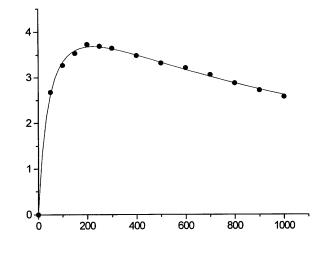
84 |
ˇ |
V. Stefuca · P. Gemeiner |
DTr (10–3 K)
Substrate concentration (mmol L–1)
Fig. 7. Effect of sucrose concentration on thermometric signal in steady-state. Invertase was immobilized on bead cellulose activated by cyanuric chloride [27]
situation the maximum reaction rate,Vm , cannot be determined independently from the parameter a. Moreover, the data serve as a relative measure of the comparison of activity among IMB preparations [30].
5.1.2.2
High Enzyme Activity
When a significant change in the substrate concentration in the column is expected, numerical integration of the model equations (26) and (27) should be applied to the experimental data. The solution was simplified by combining Eq. (27) with Eq. (26) in order to obtain the following equation, where the term (–DHr)
02
ÇCp
experimental system under investigation:
dT |
dcSb (–DHr) |
dcSb |
(29) |
5 |
= – 766 |
= – 53P. |
|
dz |
Dz ÇCP |
dz |
|
The integration of Eq. (29) gives the following algebraic equation:
DTr = (cSb1 – cSb2)P. |
(30) |
For the calculation of the thermometric signal value, DTr , the output substrate concentration cSb2 was determined by the integration of Eq. (26). Using this value and the value of the input substrate concentration, cSb1 , the heat response, DTr , was determined from Eq. (30).
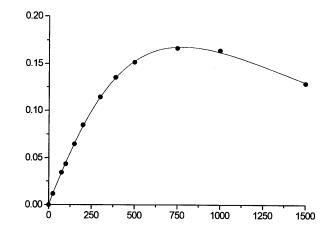
Investigation of Catalytic Properties of Immobilized Enzymes and Cells by Flow Microcalorimetry |
85 |
DTr (K)
Input sucrose concentration (mmol L–1)
Fig. 8. Flow microcalorimetric investigation of kinetic properties of invertase bound to Eupergit C activated by concanavalin A. The line corresponds to calculated data. The model involving high substrate conversion was used and parameters were estimated by nonlinear regression: Vm = 1950 mM min–1, Km = 3420 mM, Ki = 246 mM, P = 2.7 K (unpubl. results)
The results of the experimental study and mathematical modeling of the invertase-catalyzed hydrolysis of sucrose are displayed in Fig. 8. The analysis of the output substrate concentration showed substantial substrate conversion. Therefore, the data were treated by differential equations (26) and (30), whereas the kinetic parameters were fitted using nonlinear regression. Regardless of the good agreement of the calculated and experimental values, it was concluded on the basis of a comparison of kinetic parameters obtained with those known from previous works on similar preparations of immobilized invertase [30] that this method did not provide reliable results.
In contrast, the measurement of the kinetic properties of immobilized urease under conditions of high substrate conversion resulted in “good” data [25]. Evidently, the increased substrate conversion in the microcalorimetric column increases the change in temperature. Thus, better control of heat loss is necessary. Moreover, the treatment of data of integral reactor is more complicated, and can lead to larger errors of parameter estimates. In spite of these difficulties, it is worth putting more effort into the development of methods based on higher substrate conversion because it could be very useful in the investigation of product inhibition effects and in the case of enzyme reactions with low enthalpy of reaction.
5.1.3
Enzyme Systems Influenced by Particle Diffusion Limitation
Many immobilization techniques provide biocatalysts in which the enzyme is immobilized in the porous structure of the biocatalyst particle. In such cases,the
86 |
ˇ |
V. Stefuca · P. Gemeiner |
observed biocatalytic reaction rate is influenced by exchange of mass between the interior of the particle and its surroundings. A reaction rate profile is built up inside the particle, and the overall reaction rate is different from the kinetic rate. Therefore, the effectiveness factor is not longer unity and its value must be introduced into the mathematical model. The effectiveness factor is calculated by solving the particle mass balance equations (7) and (8).
The first investigation of the influence of particle mass transfer on the reaction kinetics in a flow microcalorimeter, dealing with properties of urease immobilized on controlled pore glass, was published in 1985 [25]. More recently,the evaluation of microcalorimetric data in the case of particle-diffusion limitation was improved and simplified by introducing the principle of the differential bed [28, 29].
In certain cases, restriction of the experimental conditions to low substrate concentrations (cS Km) is an acceptable condition for the investigation of biocatalyst properties. In this case, the enzyme kinetics can be simplified to the
form of a pseudo-first order kinetics expressed by the relation |
|
Vm |
(31) |
v (cS , cP , P) = 5cS = k1cS |
|
Km |
|
where k1 is the pseudo-first order rate constant. Then, Eq. (7) can be solved analytically and, for example, in the case of spherical geometry the following explicit expression can be obtained for the effectiveness factor calculation [36]:
3 |
1 |
1 |
|
h = 3 |
6322 |
– 3 |
(32) |
F |
tanh F |
F |
|
where F is the Thiele modulus
5
F = R d34k1 . (33) DS
This approach was used in the study of the properties of D-amino acid oxidase isolated or fixed in cells of Trigonopsis variabilis and entrapped in calcium pectate or polyacrylamide gel [28]. The approach of a differential reactor (low enzyme activity in the packed bed) was applied. The experimental thermometric data, DTr , were transformed to reaction rates, vobs , according to Eq. (21), whereas parameter a was determined by the calibration shown in Fig. 5. The data were described by the equation
(1–e)
vobs = hvkin = h 63k1cSb (34) e
that was obtained by combining Eqs. (6), (14) and (31). The kinetic parameter, k1 , was evaluated by comparing the experimental and calculated data. The results of the treatment of the data,listed in Table 2,illustrate the influence of cell

Investigation of Catalytic Properties of Immobilized Enzymes and Cells by Flow Microcalorimetry |
87 |
Table 2. Intrinsic rate constant and effectiveness factor values of D-amino acid oxidase immobilized in calcium pectate gel studied by flow microcalorimetry [28]
Parameters |
Cell loading concentration |
|
|
||
|
(mg dry mass mL–1 gelling suspension) |
|
|||
|
|
|
|
|
|
|
24.0 |
34.2 |
48.0 |
60.0 |
79.9 |
|
|
|
|
|
|
k1 (min–1) |
0.45 |
0.60 |
1.45 |
1.18 |
4.50 |
Thiele modulus, F (–) |
3.08 |
3.55 |
5.52 |
4.98 |
9.73 |
Effectiveness factor, h (–) |
0.66 |
0.60 |
0.44 |
0.47 |
0.27 |
|
|
|
|
|
|
loading on the activity and effectiveness of the biocatalyst. The advantage of this approach is the ease and rapidity with which the experimental data are treated. This is very useful for a simple comparison of the intrinsic activity of different biocatalysts.
In spite of usefulness of the simplification obtained by decreasing the experimental substrate concentration, many studies are aimed at the investigation of kinetic properties of immobilized biocatalysts within broader concentration ranges. In a previous paper [29], cells of Escherichia coli with penicillin acylase activity were immobilized by entrapment in calcium pectate gel and tested on the transformation of penicillin G to 6-amino penicillanic acid. Figure 9 shows experimental data from a microcalorimetric investigation of the penicillin G transformation in steady state.As appreciable particle-mass transfer was expected, the mathematical model that includes particle-mass balance was used.
Fig. 9. Kinetic measurement of the calcium pectate gel immobilized penicillin acylase in the flow microcalorimeter. Cell loading concentrations (mg of dry weight per mL of gelling suspension): (●) 11.9; (■) 23.7; (▲) 29.6 [29]
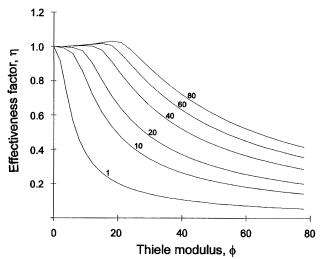
88 |
ˇ |
V. Stefuca · P. Gemeiner |
The experimental data shown in Fig. 9 were used for the determination of the kinetic parameters. The kinetic model of substrate inhibition was in the form:
|
VmcSb |
|
v(cS , cP , P) = 42594 |
(35) |
|
|
cSb2 |
|
|
Km + cSb + 41 |
|
|
Ki |
|
1– e |
VmcSb |
|
vobs = h 6 42594. |
(36) |
|
e |
cSb2 |
|
|
Km + cSb + 41 |
|
|
Ki |
|
The thermometric data in Fig. 9 were transformed via parameter a, which was determined by calibration [29] and used to determine the kinetic parameters Vm , Km and Ki in Eq. (36) by nonlinear regression. The effectiveness factor values were calculated by solving Eq. (7) using the orthogonal collocation procedure [37]. As can be seen in Fig. 9, the kinetic behavior corresponds to a reaction slightly inhibited by substrate. When the bulk concentration of the substrate exceeds the maximum on the kinetic curve, the resistance to mass transfer can increase the reaction rate by decreasing the actual substrate concentration in the enzyme site. Generally, this situation is expressed by effectiveness factor values being greater than 1. Values of the effectiveness factor calculated on the basis of kinetic parameters obtained for penicillin acylase are represented in Fig. 10.
Fig. 10. Effectiveness factor values for immobilized penicillin acylase calculated by Eq. (6). Kinetic parameter values (Km = 1.5 mM, Ki = 570 mM) were calculated from results in Fig. 11. Parameter of lines is input penicillin G concentration in mM [29]
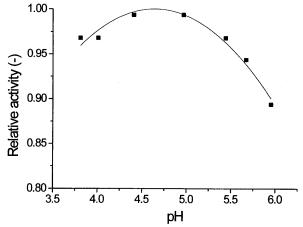
Investigation of Catalytic Properties of Immobilized Enzymes and Cells by Flow Microcalorimetry |
89 |
Fig. 11. Microcalorimetric investigation of pH-activity profile of invertase immobilized on Eupergit C by direct binding (unpublished results)
5.2
pH-Activity Profiles
The investigation of pH-activity profiles is a typical measurement when a relative activity change provides sufficient information about the enzyme properties. Equation (21) reminds us that the actual reaction rate in the column is directly proportional to the measured thermometric signal, on condition that the column is packed with a differential amount of IMB. Since the reaction rate is proportional to the IMB activity, the activity is proportional to the thermometric signal, as well. Therefore, the measurement of the relative change of thermometric signal due to the pH change can be used instead of conventional techniques for the investigation of pH-activity. Once more, enzyme flow microcalorimetry proves to be a robust, efficient and accurate method.
An example of such a result is illustrated in Fig. 11 showing the pH-activity profile of invertase immobilized on Eupergit C. The relative activity plotted in the figure is the ratio of the thermometric signal at given pH divided by the maximum value of the thermometric signal observed at the pH optimum. The value of the pH optimum obtained is comparable to the known value for yeast invertase [38].
5.3
Biocatalyst Stability
As in the case of pH-activity measurement, the investigation of enzyme stability is quite often satisfied by obtaining information about the relative decrease of activity during the enzyme operation,without knowing the absolute value of the activity during the experiment. Figure 12 shows the stability of invertase bound
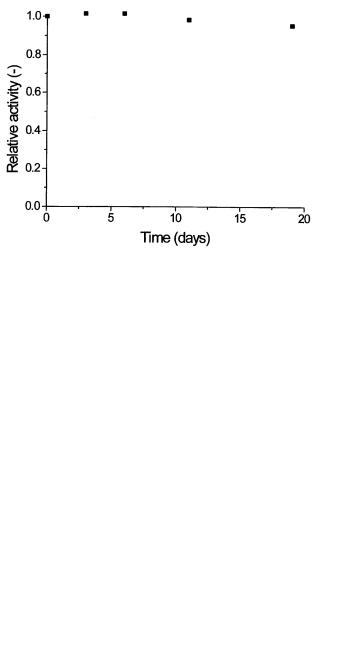
90 |
ˇ |
V. Stefuca · P. Gemeiner |
Fig. 12. Operational stability of invertase immobilized on Eupergit C investigated by flow enzyme microcalorimetry. Temperature 30 °C, flow rate 1 mL min–1 unpublished results
on Eupergit C and measured by flow microcalorimetry. The thermometric data were normalized using the initial value of thermometric signal as a norm.
The operational stability of Trigonopsis variabilis cells with D-amino acid oxidase activity, entrapped in standard and hardened ionotropic gels, was also investigated by means of the FMC [39]. The activity of the biocatalyst packed in the FMC column was continuously monitored by the FMC signal measurement
Fig. 13. Operational stability of D-amino acid oxidase fixed in cells of Trigonopsis variabilis CCY 15-1-3 entrapped in standard (▲ ) and hardened (▲) calcium pectate gel and standard (●) and hardened calcium alginate gel (●). The relative activity was monitored by continuous processing, with the substrate (cephalosporin C) solution in the flow microcalorimeter [39]
Investigation of Catalytic Properties of Immobilized Enzymes and Cells by Flow Microcalorimetry |
91 |
when cephalosporin C solution was fed into the system. The results shown in Fig. 13 clearly demonstrate the superior stability of hardened calcium pectate gel biocatalyst particles.
Another type of stability of immobilized biocatalysts is the retention of activity after periodic use in batch processes,as has been reported previously for penicillin acylase entrapped in polyacrylamide gel [40]. This option can be used to advantage for rapid monitoring of biocatalyst activity under conditions of industrial application. Apart from the measurement of activity as an indication of the necessity to replace the biocatalyst, the periodic analysis of the variation of kinetic properties permits greater insight into deviation from the optimal parameters.
Flow microcalorimetry allows the investigation of the relation between environmental conditions and enzyme stability. For example, the influence of ethanol concentration on the stability of immobilized invertase was studied this way [33].
5.4 Inhibition
Flow microcalorimetry was used for the investigation of product inhibition in the urea–urease system [25]. Inhibition was induced by the product of the reaction. As mentioned above, this was a case in which the model had to be in the form of differential equations, and the mass and heat balance had to be solved by integration of these equations along the column. Another approach was adopted in the investigation of invertase inhibition by products of sucrose hydrolysis [33]. In this work, inhibition was observed qualitatively when samples of sucrose with different concentrations of products (glucose or fructose) were fed into the immobilized enzyme column of the microcalorimeter. Unfortunately, there are only a few reports nowadays about enzyme inhibition analysis by flow microcalorimetry at the level of mathematical modeling published in the literature.The majority of studies are concerned with the inhibitory effect of substrate [27, 29–31]. In these investigations the mathematical treatment of data is presented in simplified form, using the approaches described above. Many kinetic models, including the inhibitory effects of compounds on an enzyme, fit a kinetic equation of the following general form
VmcS
v (cSb , cPb , P) = 59652 (37) f (Km , Ki , cS , ci)
where ci is the inhibitor concentration and the function f in the denominator is a general representation of denominators in kinetic equations involving inhibition. Thus, when thermometric data are converted to reaction rates, the following equation can be used for their description
1 – e |
VmcS |
(38) |
vobs = h 7 |
59625 . |
|
e |
f (Km , Ki , cS , ci) |
|
92 |
ˇ |
V. Stefuca · P. Gemeiner |
The analysis of substrate inhibition based on Eq. (38) was performed for immobilized penicillin acylase as mentioned above. However, if particle mass transfer can be neglected, an even simpler approach can be adopted, using the equation that is valid for the differential bed
|
1 – e |
cS |
a¢ cS |
(39) |
DTr = a 7Vm 59625 |
= 59265 . |
|||
|
e |
f (Km , Ki , cS , ci) |
f (Km , Ki , cS , ci) |
|
Since quantities in the first parenthesis are constant, they can be regrouped in a single parameter, a¢. Thus, all parameters in the denominator of the kinetic term can be determined directly by nonlinear regression from thermometric data. Combining Eq. (39) with the kinetic model of the sucrose hydrolysis catalyzed by invertase represented by Eq. (25) we obtain
|
a¢ cSb |
W |
(40) |
|
DTr = 94936 . |
||||
K |
+ c |
+ c2 |
W |
|
m |
Sb |
Sb |
0 |
|
|
|
5 |
|
|
|
|
Ki |
|
|
The last equation was used in several papers studying the kinetic properties of invertase, where substrate inhibition was evaluated in terms of the inhibition parameter Ki [27, 30, 31].
5.5
Screening of Immobilized Biocatalysts
Flow microcalorimetry,which makes many rapid and accurate measurements of the activity of immobilized biocatalysts, provides a tool for researchers that can be used to discriminate between different preparatives of immobilized biocatalysts. Table 3 shows previous experiments where the characterization of kinetic properties by flow microcalorimetry was used to compare different techniques of purified enzyme immobilization [27, 30, 31, 35] as well as the immobilization of enzymes fixed in cells [28, 29, 40]. More details can be found in our recent review article [41].
5.6
Monitoring of Enzymes Immobilized on Affinity Sorbents
While the interest in irreversible and covalent methods of immobilization continues, bioaffinity-based procedures are gaining appreciable attention, especially for analytical applications [42]. Compared to other methods of immobilization, those based on bioaffinity offer several distinct advantages. These include:
1.Binding of the enzyme to an affinity support may be very strong and yet reversible under specific conditions;
2.The immobilization process is usually simple, and necessitates no special skills;
